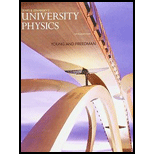
CP Global Positioning System (GPS). The GPS network consists of 24 satellites, each of which makes two orbits around the earth per day. Each satellite transmits a 50.0-W (or even less) sinusoidal
Want to see the full answer?
Check out a sample textbook solution
Chapter 32 Solutions
University Physics (14th Edition)
Additional Science Textbook Solutions
Essential University Physics: Volume 2 (3rd Edition)
Essential University Physics (3rd Edition)
The Cosmic Perspective
Conceptual Integrated Science
Essential University Physics: Volume 1 (3rd Edition)
- Suppose the magnetic field of an electromagnetic wave is given by B = (1.5 1010) sin (kx t) T. a. What is the maximum energy density of the magnetic field of this wave? b. What is maximum energy density of the electric field?arrow_forwardThe electric field of an electromagnetic wave traveling in vacuum is described by the following wave function: E =(5.00V/m)cos[kx(6.00109s1)t+0.40] j where k is the wavenumber in rad/m, x is in m, t s in Find the following quantities: (a) amplitude (b) frequency (c) wavelength (d) the direction of the travel of the wave (e) the associated magnetic field wavearrow_forwardWhat is the average magnitude of the Poynting vector 5.00 mi from a radio transmitter broadcasting isotropically (equally in all directions) with an average power of 250 kW?arrow_forward
- A plane electromagnetic wave travels northward. At one instant, its electric field has a magnitude of 6.0 V/m and points eastward. What are the magnitude and direction of the magnetic field at this instant?arrow_forwardDuring normal beating, the heart creates a maximum 4.00-mV potential across 0.300 m of a person’s chest, creating a 1.00-Hz electromagnetic wave. (a) What is the maximum electric field strength created? (b) What is the corresponding maximum magnetic field strength in the electromagnetic wave? (C) What is the wavelength of the electromagnetic wave?arrow_forwardFigure P24.13 shows a plane electromagnetic sinusoidal wave propagating in the x direction. Suppose the wavelength is 50.0 m and the electric field vibrates in the xy plane with an amplitude of 22.0 V/m. Calculate (a) the frequency of the wave and (b) the magnetic field B when the electric field has its maximum value in the negative y direction. (c) Write an expression for B with the correct unit vector, with numerical values for Bmax, k, and , and with its magnitude in the form B=Bmaxcos(kxt) Figure P24.13 Problems 13 and 64.arrow_forward
- If the electric field of an electromagnetic wave is oscillating along the z-axis and the magnetic field is oscillating along the x-axis, in what possible direction is the wave traveling?arrow_forwardShow that for a continuous sinusoidal electromagnetic wave, the peak intensity is twice the average intensity (I0 = 2Iave), using enter the fact that E0=2Erms, or B0=2Brms, where rms means average (actually root mean square, a type of average).arrow_forwardThe following represents an electromagnetic wave traveling in the direction of the positive y-axis: Ex=0;E0cos(kxt);Ez=0Bx=0;By=0;Bz=B0cos(kxt) The wave is passing through a wide tube of circular cross- section of radius R whose axis is along they-axis. Find the expression for the displacement current through the tube.arrow_forward
- Assume the mostly infrared radiation from a heat lamp acts like a continuous wave with wavelength 1.50 µm. (a) If the lamp’s 200-W output is focused on a person’s shoulder, over a circular area 25.0 cm in diameter, what is the intensity in W/m2? (b) What is the peak electric field strength? (c) Find the peak magnetic field strength. (d) How long will it take to increase the temperature of the 4.00-kg shoulder by 2.00º C , assuming no other heat transfer and given that its specific heat is 3.47×103 J/kg⋅ºC?arrow_forwardAssume the mostly infrared radiation from a heat lamp acts like a continuous wave with wavelength 1.50 µm . (a) If the lamp’s 200-W output is focused on a person’s shoulder, over a circular area 25.0 cm in diameter, what is the intensity in W/m2 ? (b) What is the peak electric field strength? (c) Find the peak magnetic field strength. (d) How long will it take to increase the temperature of the 4.00-kg shoulder by 2.00º C , assuming no other heat transfer and given that its specific heat is 3.47×103 J/kg ⋅ ºC ?arrow_forwardA sinusoidal electromagnetic wave is propagating in vacuum in the +z-direction. If at a particular instant and at a certainpoint in space the electric field is in the +x-direction and has magnitude 4.00V/m, what are the magnitude and direction of the magnetic field of the wave at this same point in space and instant in time?arrow_forward
 Physics for Scientists and Engineers: Foundations...PhysicsISBN:9781133939146Author:Katz, Debora M.Publisher:Cengage Learning
Physics for Scientists and Engineers: Foundations...PhysicsISBN:9781133939146Author:Katz, Debora M.Publisher:Cengage Learning Principles of Physics: A Calculus-Based TextPhysicsISBN:9781133104261Author:Raymond A. Serway, John W. JewettPublisher:Cengage Learning
Principles of Physics: A Calculus-Based TextPhysicsISBN:9781133104261Author:Raymond A. Serway, John W. JewettPublisher:Cengage Learning
 College PhysicsPhysicsISBN:9781938168000Author:Paul Peter Urone, Roger HinrichsPublisher:OpenStax College
College PhysicsPhysicsISBN:9781938168000Author:Paul Peter Urone, Roger HinrichsPublisher:OpenStax College Physics for Scientists and Engineers, Technology ...PhysicsISBN:9781305116399Author:Raymond A. Serway, John W. JewettPublisher:Cengage Learning
Physics for Scientists and Engineers, Technology ...PhysicsISBN:9781305116399Author:Raymond A. Serway, John W. JewettPublisher:Cengage Learning




